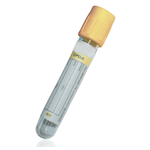Suitable Specimen Types
- Serum
- EDTA Plasma
- Li Hep Plasma
Sample Processing in Laboratory
Usual
Sample Preparation
Centrifuge specimen
Turnaround Time
1 DaySample Stability
Serum specimens in gel tubes are stable at 4ºC for 2 days, plain tubes are stable for up to 5 days. For longer periods store aliquots at -20ºC.
Progesterone
General Information
Progesterone is a steroid hormone, which plays an important role in the preparation for the maintenance of pregnancy. Progesterone is mainly formed in the cells of the corpus luteum and during pregnancy in the placenta. The progesterone concentration correlates with the development and regression of the corpus luteum.
Progesterone levels are characteristically low during the follicular phase and increase sharply during the luteal phase of menstrual cycle. Progesterone brings about the conversion of the uterine mucosa into a tissue rich in glands (secretion phase), in order to prepare for the intrauterine implantation of the fertilized ovum. Unless pregnancy occurs, a steep decline to follicular levels sets in about 4 days before the next menstrual period. This pattern constitutes the rational behind the well-established use of serum progesterone measurements as a simple and reliable method for ovulation detection. Progesterone measurement is also used to help diagnose an ectopic or failing pregnancy, to monitor the health during pregnancy, and to help diagnose the cause of abnormal uterine bleeding
Patient Preparation
None
Notes
Sodium citrate and sodium fluoride/potassium oxalate plasma may also be used.
Reference Range
Males: 0.32 - 0.64 nmol/L
Females:
0.32 - 0.95 nmol/L(follicular)
3.8 - 50.6 nmol/L(luteal)
0.32- 0.64 nmol/L(Post-Menopausal)
Specifications
- EQA Scheme?: Yes
-
EQA Status:
NEQAS and WEQAS
